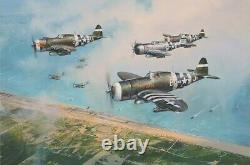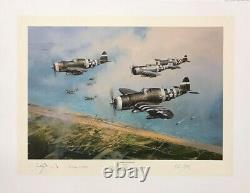
- Home
- Edition Size
- Edition Type
- Listed By
- Print Type
- Signed
- Subject
- -------- (25)
- --------, Military (8)
- Aircraft (59)
- Aircraft, Military (25)
- Art & Photography (2)
- Eagle (12)
- Education (3)
- History (59)
- History, Military (4)
- Literature & Fiction (3)
- Luftwaffe (6)
- Military (100)
- Military & Political (55)
- Military, -------- (4)
- Mustang (4)
- Paris (2)
- Stars (4)
- Transportation (59)
- Women (3)
- Zemke's Wolfpack (2)
- Other (654)
Hell Hawks over Utah, Robert Taylor aviation art signed by D-Day Fighter Pilots




As elements of the US VII Corps storm ashore on Utah beach below, P-47D Thunderbolts from the 365th Fighter Group, US Ninth Air Force - The Hell Hawks - overfly the Normandy bridgehead on the morning of D-Day, 6 June 1944. Flying from their base in southern England, the mighty Hell Hawks head inland to attack and successfully suppress German positions in support of the American advance. Without air supremacy D-Day and the invasion of north-west Europe would never have happened, and the tactical Ninth Air Force played a huge part in securing that position. The Ninth had fought with distinction from the deserts of North Africa to the invasion of Sicily and the fighting in Italy. They had spearheaded the assault on Ploesti and, from humble beginnings, had grown into one of the finest and most formidable Air Force's in the USAAF.
Then, in October 1943, the Ninth were sent to England for their greatest challenge so. Far - providing air support for the US First Army during the forthcoming invasion of Normandy. By the morning of 6 June 1944 the Ninth was the largest and most effective tactical air force in the world, with over a quarter of a million personnel and more than 3,500 fighters, bombers and troop-carriers under its command. Amongst them were the P-47s of the 365th Fighter Group - the fearsome "Hell Hawks" - a unit that would become legendary by the end of WWII. Amongst the first to use P-47s as fighter-bombers, the Hell Hawks were hard at work softening up the enemy in the build-up to D-Day, dive-bombing bridges, rail lines, gun positions and airfields.
With two 1,000-pound bombs below their wings along with ten 5 rockets and eight. 50 calibre machine guns, their enormous firepower devastated the German defenses on D-Day. The Hell Hawks supported the army throughout the Normandy campaign, all the way across northern France to the Battle of the Bulge in December 1944, and beyond. It was a harsh nomadic life, eating and sleeping in tents and moving from one temporary strip to the next.By the end of hostilities in May 1945 the Hell Hawks had moved through 11 different airfields, more than any other fighter-bomber group in the Ninth Air Force. Robert Taylor's outstanding Masterwork, specially commissioned to commemorate the 70th Anniversary of D-Day and the battle for Normandy, pays tribute to the roughnecks of the 365th Fighter Group as they cross Utah Beach on the morning of 6 June 1944.
They will shortly be in action taking out German armored units resisting the advance of the US First Army from the invasion beaches. This outstanding print is individually numbered and personally signed by the artist and two Hell Hawk pilots creating a valuable and historic collectors piece.

